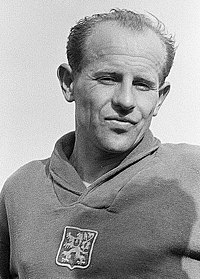Mistrzostwa Europy w Lekkoatletyce 1954 – bieg na 5000 m mężczyzn
| |||
Bieg na dystansie 5000 metrów mężczyzn był jedną z konkurencji rozgrywanych podczas V Mistrzostw Europy w Bernie. Biegi eliminacyjne zostały rozegrane 26 sierpnia, a bieg finałowy 29 sierpnia 1954 roku. Zwycięzcą tej konkurencji został reprezentant ZSRR Wołodymyr Kuc. W rywalizacji wzięło udział dwudziestu ośmiu zawodników z dziewiętnastu reprezentacji.
Rekordy
| Rekord świata | 13:57,2 | Colombes, Francja | 30.05.1954[1] | |
| Rekord Europy | 13:57,2 | Colombes, Francja | 30.05.1954 | |
| Rekord mistrzostw | 14:03,0 | Bruksela, Belgia | 26.08.1950 |
Wyniki
Eliminacje
Bieg 1
| Miejsce | Zawodnik | Czas | Uwagi |
|---|---|---|---|
| 1 | 14:42,8 | Q | |
| 2 | 14:42,8 | Q | |
| 3 | 14:43,0 | Q | |
| 4 | 14:43,6 | Q | |
| 5 | 14:44,0 | Q | |
| 6 | 14:47,0 | ||
| 7 | 14:51,0 | ||
| 8 | 14:54,8 | ||
| 9 | 14:59,4 |
Bieg 2
| Miejsce | Zawodnik | Czas | Uwagi |
|---|---|---|---|
| 1 | 14:18,8 | Q | |
| 2 | 14:23,8 | Q | |
| 3 | 14:29,2 | Q | |
| 4 | 14:36,2 | Q | |
| 5 | 14:36,2 | Q | |
| 6 | 14:37,4 | ||
| 7 | 14:42,4 | ||
| 8 | 15:28,6 | ||
| – | DNF | ||
| – | DNF |
Bieg 3
| Miejsce | Zawodnik | Czas | Uwagi |
|---|---|---|---|
| 1 | 14:38,4 | Q | |
| 2 | 14:38,6 | Q | |
| 3 | 14:40,0 | Q | |
| 4 | 14:40,0 | Q | |
| 5 | 14:42,0 | Q | |
| 6 | 14:46,2 | ||
| 7 | 14:48,4 | ||
| 8 | 14:55,8 | ||
| 9 | 15:21,8 |
Finał
| Miejsce | Zawodnik | Czas | Uwagi |
|---|---|---|---|
| 1 | 13:56,6 | ||
| 2 | 14:08,8 | ||
| 3 | 14:10,2 | ||
| 4 | 14:20,0 | ||
| 5 | 14:25,6 | ||
| 6 | 14:31,4 | ||
| 7 | 14:32,2 | ||
| 8 | 14:32,4 | ||
| 9 | 14:44,6 | ||
| 10 | 14:48,6 | ||
| 11 | 15:22,8 | ||
| – | DNF | ||
| – | DNF | ||
| – | DNF | ||
| – | DNF |
Przypisy
- ↑ Progression of IAAF World Records. 2015 Edition, IAAF, s. 86 [dostęp 2017-09-09] (ang.).
Bibliografia
- Amsterdam 2016 Statistics Handbook, European Athletics, s. 394-395 [dostęp 2017-09-09] [zarchiwizowane z adresu 2016-09-18] (ang.).
- European Athletics Championships – Bern 1954, European Athletics [dostęp 2017-09-09] (ang.).
|
Media użyte na tej stronie
Pictograms of Olympic sports – . This is an unofficial sample picture. Images of official Olympic pictograms for 1948 Summer Olympics and all Summer Olympics since 1964 can be found in corresponding Official Reports.
An icon that represents a gold medal
An icon that represents a silver medal
An icon that represents a bronze medal
Autor: Scroch, Licencja: CC BY-SA 4.0
National Flag of the People's Republic of Bulgaria (1948-1967). Tha flag has got the coat-of-arms from 1948
Flaga Finlandii
Sport records icon to be used for national records.
Autor: Pedro A. Gracia Fajardo, escudo de Manual de Imagen Institucional de la Administración General del Estado, Licencja: CC0
Flaga Hiszpanii
Flag of the Socialist Federal Republic of Yugoslavia (1946-1992).
The design (blazon) is defined in Article 4 of the Constitution for the Republic of Yugoslavia (1946). [1]
Flag of the Socialist Federal Republic of Yugoslavia (1946-1992).
The design (blazon) is defined in Article 4 of the Constitution for the Republic of Yugoslavia (1946). [1]
Flag of Portugal, created by Columbano Bordalo Pinheiro (1857-1929), officially adopted by Portuguese government in June 30th 1911 (in use since about November 1910). Color shades matching the RGB values officially reccomended here. (PMS values should be used for direct ink or textile; CMYK for 4-color offset printing on paper; this is an image for screen display, RGB should be used.)
Sport records icon to be used for world records.
Autor: Bert Verhoeff / Anefo, Licencja: CC0
Tentoonstelling Europort 1972 geopend in de RAI, Minister Chris Chataway aan stuur hoovercraft
- 14 november 1972
Autor:
- Fotothek_df_roe-neg_0006305_003_Emil_Zátopek.jpg: Roger Rössing
- derivative work: MachoCarioca
Emil Zatopek, 1951.
























